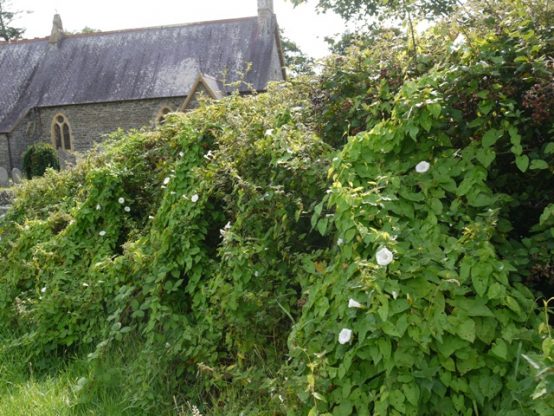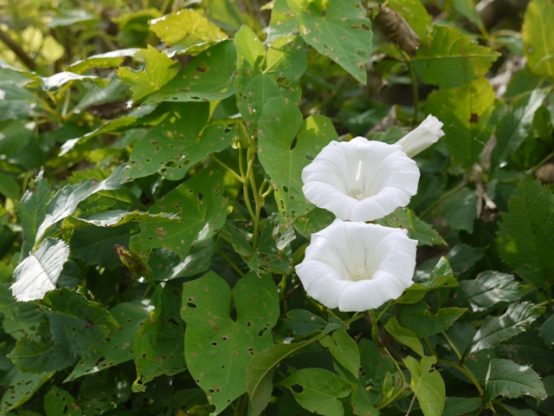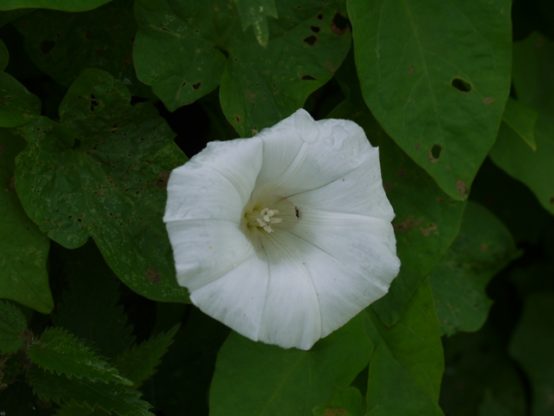by The Curious Scribbler
The convolvulus family includes several choice and garden-worthy species, such as the silver-foliaged shrub Convolvulus cneorum, and the sky blue Convolvulus mauritanicus of the hanging basket, but it also includes the gardener’s foe Calystegia sepium, the field bindweed. Who has not engaged in an unending struggle with this plant!
Emerging from the ground as the frosts have passed its fine tendrils twist their way up the young stems of our newest seedlings or the woody stems of established shrubs. Romping to the top, the new growth soon expands to form a heavy leafy mass which all too soon entirely swamps the substrate. We pluck it, unwind it, dig up the white wandering roots and still it comes, for the brittle roots go deep and readily break when removed. A tiny half inch of root will soon sprout a new plant, initially an innocent miniature tendril, but left unnoticed soon expanding to its gorgon like best.

Field Bindweed Calystegia sepium smothering a hedge

Field Bindweed Calystegia sepium
In hedgerows it is unassailable, and by this time of year may largely cover the hedge beneath. But it redeems itself in the wild by the beauty of its flowers, great luminous white trumpet blooms opening freshly every day. As a flower it puts Morning Glory in the shade, and would be much prized if only like Morning Glory it discreetly died each winter. Instead, the roots burrow onward and a fresh supply of seeds ensure its rapid introduction far and wide.

Field Bindweed Calystegia sepium
The very best gardens suffer from Bindweed. I recently heard a talk by Debs Goodenough, Royal Gardener at Highgrove for the Prince of Wales, who was addressing the AGM of the Welsh Historic Gardens Trust. The Prince is conscientiously organic, so chemicals are not in the arsenal. It was fascinating to learn that in the last few years they have been trialling a new method of attack – by electrocution! 5000 volts is applied to the stem. It is satisfying, she said, to see a puff of smoke emerge from the ground.
I’ve just been watching a YouTube film by the company Rootwave introducing the Rootwave Pro. Rather than crouching with a widger the gardener strolls around with an electrocution wand attached to a small generator, poking it into selected dandelions, hogweed, thistles and so on. As the publicity puts it – the plants boil from the inside, die and return their goodness to the soil. This is new technology and Debs was not yet ready to vouch for its effectiveness. I do wonder whether, with the long roots of bindweed said to penetrate as much as 20 feet into the ground, the boiling plant near the surface will leave a healthy root fragment deep below, capable of sprouting a new plant to re-invade.
I wonder also how the 5000 volt affects the nearby soil invertebrates, there must be a fair number of worms which, if not cooked, get the fright of their lives. I’m feeling rather respectful of worms just now having spent an hour watching the progress of a mole through the surface of a meadow. Excavating with its powerful claws under the root mat of the grass the mole generates audible scrunching vibrations as it creates a run just below the surface. And don’t the worms know! In its immediate vicinity I watched worms of all sizes hurriedly emerging onto the surface of the grass and hastening 10 centimetres or more across the surface in braod daylight before disappearing once more below ground. I don’t suppose that evolution has equipped worms with a similar sixth sense when the approach of the Rootwave operator is nigh.
It is good to know that HRH is experimenting with the latest in organic techniques. We also learnt that his magnificent delphiniums receive their slug protection through garlands of seaweed mulched around each plant, and that he is keen to obtain disabled hedgehogs from hedgehog hospitals. A fully able hedgehog requires a substantial range and the breeding opportunities which that affords. A troupe of disabled yet hungry hedgehogs could just hang around the Highgrove borders eating their fill of slugs and snails.

An interesting article which left me with a smile on my face.
Thank you! Its lovely to get feedback from readers
Decades ago I was employed to conduct mineral exploration surveys on the hills inland from Aber. One of the techniques involved putting 15,000 volts into the ground through stainless steel stakes. We certainly saw very many earthworms shoot to the surface violently wriggling, although the area affected only seemed to be within a couple of yards of the stakes.
One site was on top of a badger sett in the woods above Old Goginan. It looked abandoned but for a couple of days beforehand I checked thin twigs across all the entrances had not been disturbed, I am confident we fried no badgers.
That is interesting. Sounds like a lot of worms were affected. It raises the question whether electrocution is any kinder to the environment that glyphosate.
Rather oddly, we did not see any dead worms. Maybe that was because we moved rapidly on to a new position, but when we left they were still wriggling. Perhaps there were dead worms underground. (I had a short dose of 15,000 volts through myself one day above Cwmsymlog but survived.)